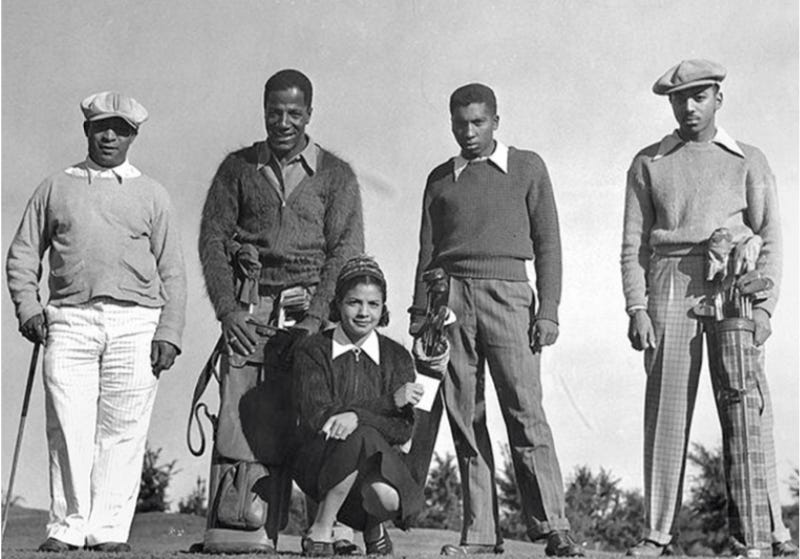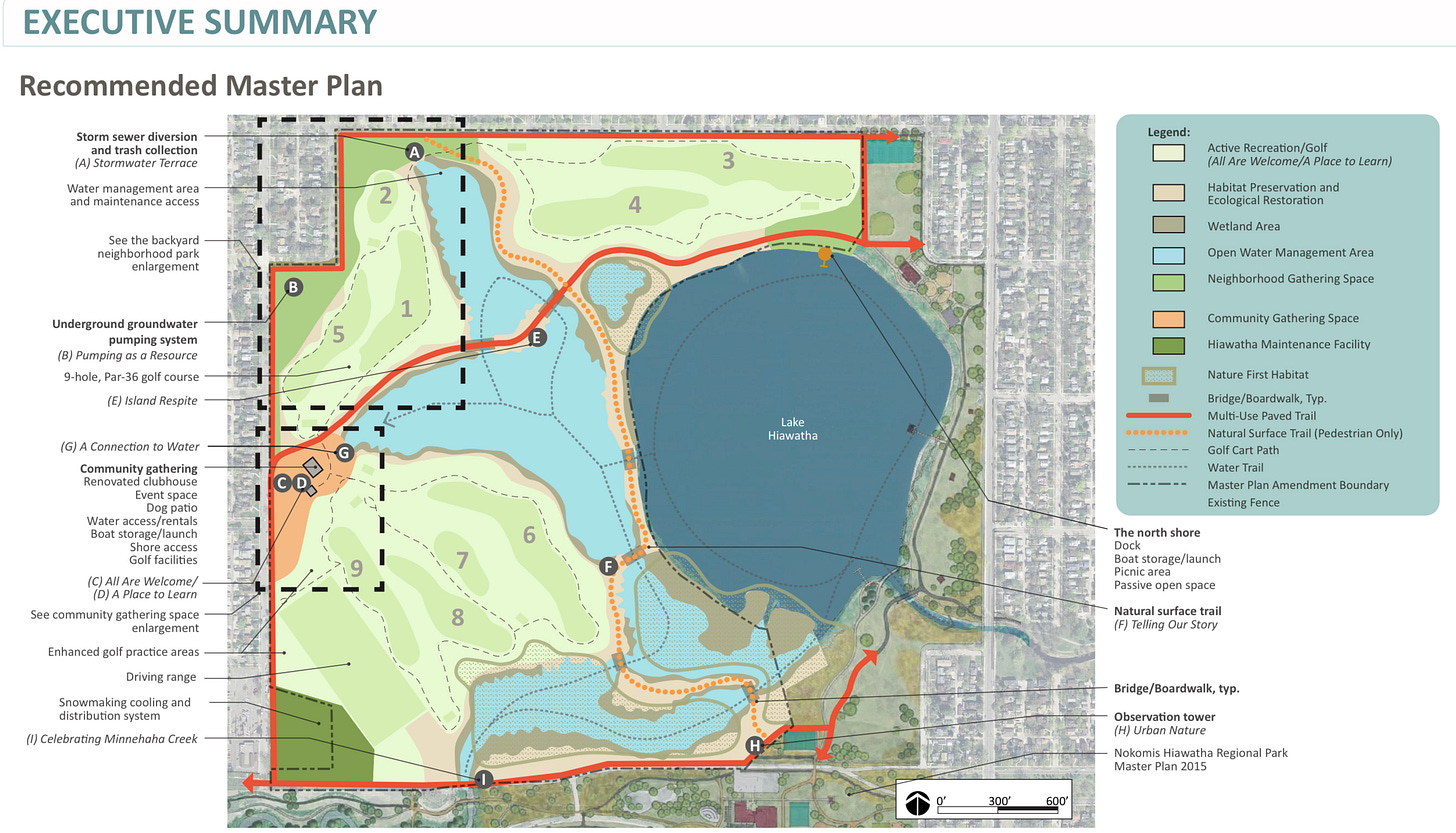Minneapolis Parks Department pillages golf course revenue as the fate of Hiawatha Golf Course remains a mystery
A $43 million dollar proposal does little to address this historic Minneapolis golf course.
Hiawatha Golf Course has been in purgatory for years now. The city council has proposed renovation of the space returning some land to the flood plane and some to other public works and outreach. It’s history stands as its safeguard.
The course designed by William D Clarke was officially completed in 1934 and measured to 6967 yards. It was the longest public course in Minneapolis at the time. As one of the longest public courses, Hiawatha became the site of “The Bronze” after it moved from Gross and Theo Worth golf courses. The famed prize fighter Joe Louis won the tournament in 1957. Located in a predominantly black community, Hiawatha was the most popular course in the Minneapolis system.
Golfers Jimmy Slemmons, second from left, and Rosella Ellis, front, 1938, ca (Source: Minnesota Historical Society)
Hiawatha is not without its needs: in 1948, the first fairway was raised to prevent flooding. In 1953, workers placed fill along the lake shore and creek bank to prevent overflowing and built two forty-foot timber bridges over the creek to replace those that had been damaged by high water the previous year. A similar bridge was built in 1956. The following year, the board installed drain lines, which ran from the sixth fairway to a concrete sump at Forty-Third Street South and Nineteenth Avenue South and installed an electric pump in 1958. The purpose of this machinery was to keep the fairways dry, allowing better golf games. A similar system was installed in 1964 to serve the seventh fairway. A sprinkling system, which could water the whole course in five days, was also built. Following floods in 1987 and 1991, course drainage was improved by elevating some of the fairways, tiling the greens, adding water hazards as water collection points, and installing new pumps. This work was done on the front nine holes in 1993 and the back nine in 1999.
The Hiawatha Golf Course has been impacted by large floods in 1952, 1965, 1987, and most recently in 2014. In June 2014, record rainfalls in the spring and early summer overtopped the berm, flooding the course for an extended period and overwhelming the pumping system. Between repairs and lost revenue, total flood costs were estimated to be $4 million. The course would not reopen until 2016.
The proposed $43 million plan envisions a new nine-hole course, a large space for water storage, and other amenities including BMX trails, a dog patio, and kayaking to replace the existing course. That proposal was narrowly defeated by the nine-member MPRB in July 2021 but is likely to be revived in Spring 2022 following the election in Nov. 2021 of seven new members.
The Minneapolis Park Department has seen historical rates in golf revenue in post Covid times. The 2022 Minneapolis Parks Budget report showed a net revenue of $564930.00. These revenues were recorded as the sum total of public courses and data specific to Hiawatha was not available to the Finical Status Report for Q3 2022. Running on a net positive is nothing new for Minneapolis golf as most years the golf courses out earn their operating costs. These positive funds, however, are moved into other initiatives.
Proposed changes to the course, its design, lake related infrastructure all vary but other successful course redesigns range from $1.2. To $4.5 million, new courses costing up to $15 million. These investments are mostly related to hole design, bunker creation and restoration, turf changes and landscape contouring. There are additional factors specific to Hiawatha, including major pumping concerns. Addressing the pumping infrastructure would allow investments to the course to be made. With very few instances of levy failure, a large investment into the surrounding wall may provide little return on investment. Other large golf projects planned for Minnesota include the creation of a new country club near Wilmer MN called Teptonka. The cost to construct the course is estimated at $7.5 million with total cost of all infrastructure (clubhouse, 20 room accommodations, infrastructure) estimated to be $21 million.
Other successful course redesigns; Winter Park Nine in Orlando area and Brackenridge Golf Course in San Antonio, boast increased fan-fair and increased revenues. Both courses above were historically significant similarly to Hiawatha, as Winter Park originally served as one of the largest golf facilities in Central Florida and Brackenridge Golf Course was the site Texas’ first professional event and the current home of the Texas Golf Hall of Fame. Investments made to these course were $1.2 and $4.5 million respectively.
With a net positive operating budget, historic ties to the golf community and the city of Minneapolis, Hiawatha Golf Course has the ability to become the starling of public golf again or to be transformed into non revenue generating common use land.






It's a tough decision, but I think the right decision is to keep it a 18-hole course and put it on the national register for what it has done for the community. Minneapolis doesn't need more soccer fields.
With the expense of a re-design, I'd wonder where the funds would come to complete it, if it went that route. With what the park board has done over the past several years, I wouldn't be surprised if they closed it with the plan to make it into 9 holes, then claim there is no money to do so and let it fall into disrepair. They've been voted down several times now and they keep pushing for it. Why can't they respect what the people of Minneapolis want and leave it an 18-hole course?
There are plenty of other places to make a "sweet 9 hole course" for SSG. I believe the old Sawmill/Stillwater Oaks land is still available. As for sustainability, you have to look at what St. Paul did with The Ponds at Battle Creek; it was profitable, had the only lighted range on this side of the metro and they still shuttered it. While a Sweetens Cove-esque 9 holer would be amazing, there is no way the park board would even consider that.
Nicely written article. Thanks for sharing. Would be a shame to invest this much into something to not have it generate any revenue. However, I don’t think the Minneapolis courses have always been profitable. I remember looking at their revenue reports from 2015-2019, and every course (except the Theo Wirth Par 3) showed consistent losses. So I don’t think it’s true that they out-earn their operating costs. Municipalities don’t have to. There isn’t livelihood on the line for the managers because a muni will almost never go under even if it runs at a loss. I don’t know what the solution for
The golf course is. It’s a crappy situation and I don’t think the park board is as invested in something of this historical significance as it should be. But I do know that if they went the renovation route, that it would take likely 30 years of a well managed golf course to recoup what was spent.